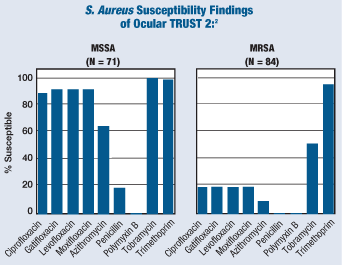 Q: What are some of the trends in the TRUST data? Are there any troubling emerging trends regarding microbial resistance?
Q: What are some of the trends in the TRUST data? Are there any troubling emerging trends regarding microbial resistance?
A: "Having done this for three years, we"ve seen consistent susceptibility patterns among these eye pathogens," says Penny Asbell, M.D., of Mount Sinai School of Medicine in
The Ocular Tracking Resistance in
Over the three years of surveillance, susceptibility profiles for Staphylococcus aureus, Streptococcus pneumoniae, and Haemophilus influenzae have been relatively stable for all of the antibiotics tested. "We know from The Surveillance Network data that more and more of the S. aureus infections we encounter are due to methicillin-resistant S. aureus (MRSA)."
In 2008, Ocular TRUST collected and examined 152 Staphylococcus aureus isolates. Of these, 48.1% were methicillin-resistant (MRSA), and the rest were methicillin-sensitive or susceptible (MSSA).
In 2006, 16.8% of S. aureus isolates were MRSA and 83.2% were MSSA.1 "TRUST has actually shown since 2000 that the number of MRSA isolates is steadily rising, while MSSA is steadily decreasing," notes Dr. Asbell.
Likewise, when it comes to coagulase-negative S. epidermidis, the 2008 findings demonstrated only a 38% methicillin-susceptibility rate--the rest were methicillin-resistant, says Dr. Asbell.

When Streptococcus pneumoniae was analyzed, the three fourth-generation fluoroquinolones were each 100% effective, followed by ciprofloxacin with a susceptibility rate of 92%. Haemophilus influenza was even more susceptible to an array of antibiotics, completely resisting only penicillin (used as a control) and demonstrating only 15% resistance to trimethoprim.2
"The take-home message is that fluoroquinolones continue to be effective against many organisms," says Dr. Asbell. "The other message: MRSA is a marker for multi-drug resistance."
But, other aspects of antibiotics also need to be evaluated to verify efficacy in the eye-such as penetration into the cornea and the drug"s persistence (i.e., how long it remains in the eye), Dr. Asbell notes.
1. Ta CN, Sahm DF. Methicillin-susceptible Staphylococcus aureus and methicillin-resistant Staphylococcus aureus: findings of Ocular TRUST. Poster presented at ASCRS/ASOA Symposium,
2. Asbell PA, Sahm DF. Longitudinal nationwide antimicrobial susceptibility surveillance in ocular isolates: results from Ocular TRUST 2. Presentation at ASCRS/ASOA Symposium,

